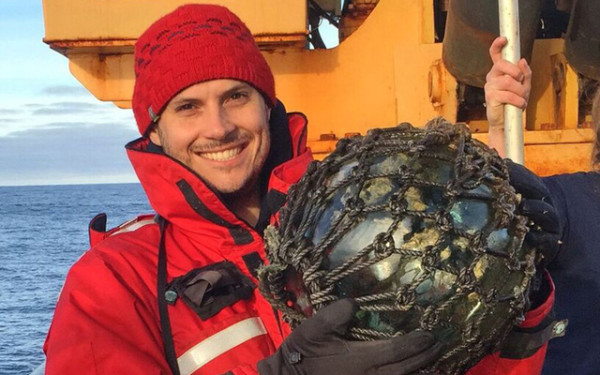Published in the Ocean Watch column, Honolulu Star-Advertiser © Susan Scott
January 25, 2016
For most of us, finding a glass fishing float washed up on a beach is like finding a crystal ball. Collecting them is addicting, and there’s no such thing as having too many.
But the green balls aren’t treasure to everyone. Japanese fishermen think they’re junk. Nor did the Japanese invent them. A Norwegian glass blower began making the floats in 1842 to hold up cod gillnets. Glass proved sturdier than wood and cork, and by the 1940s anglers in Europe, Russia, Asia and North America were all using air-filled glass forms to float their nets and mark their traps.
 Luke Halpin was the first to see the glass ball he’s holding, and
Luke Halpin was the first to see the glass ball he’s holding, and
drew his own name in an onboard lottery to become its owner.
Courtesy Jim Garrett
According to collector Walt Pich, author of several books about Pacific glass floats, Hokkaido glass blower Hisakichi Asahara was the first in Japan to make the floats, in about 1910. Asahara’s hand-blown spheres were a hit with fishers, and orders poured in.
By the 1920s the Asahara family was producing tens of thousands of glass balls in shops throughout Japan. Russian, Taiwanese and Korean glass blowers joined the boom, and by the 1930s millions of glass floats were holding up lines, nets and trawls in the Pacific.
Most Japanese floats are green because the makers used recycled green sake bottles. Other colors reflect glass reused from other sources.
Sizes varied according to need, including shapes that collectors call rolling pins, dumbbells, pumpkins and more. Glass blowers sealed the floats with so-called “buttons,” sometimes pressing trademarks into them. The Asaharas didn’t bother, leaving their buttons blank.
To hold their floats, fishers tied rope around them, often in artful knot-work. When storms tore open their coverings, the glass balls, freed from their day jobs, became drifters.
When cheaper, more durable plastic and foam floats came along, fishermen stopped buying glass ones. Today you can find new glass spheres in curio shops, but to beachcombers those don’t count. The thrill is in the finding. Or the winning. In March my friend Luke Halpin spotted a netted glass ball from the deck of a research vessel off Vancouver Island. The crew retrieved the sphere, and to be fair the captain had the names of everyone aboard put in a hat. Traditionally the person who saw the float first picked the winner. Luke drew his own name.
Those of us who have glass balls know their magic. Looking into them gives us a glimpse of a past era in a distant land and also reminds us that the Pacific Ocean is an enormous pot constantly stirring. And like all crystal balls, the floats show us a bit of our future: We will be looking for more glass balls.